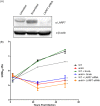Interaction of the Ankyrin H Core Effector of Legionella with the Host LARP7 Component of the 7SK snRNP Complex
- PMID: 31455655
- PMCID: PMC6712400
- DOI: 10.1128/mBio.01942-19
Interaction of the Ankyrin H Core Effector of Legionella with the Host LARP7 Component of the 7SK snRNP Complex
Abstract
Species of the Legionella genus encode at least 18,000 effector proteins that are translocated through the Dot/Icm type IVB translocation system into macrophages and protist hosts to enable intracellular growth. Eight effectors, including ankyrin H (AnkH), are common to all Legionella species. The AnkH effector is also present in Coxiella and Rickettsiella To date, no pathogenic effectors have ever been described that directly interfere with host cell transcription. We determined that the host nuclear protein La-related protein 7 (LARP7), which is a component of the 7SK small nuclear ribonucleoprotein (snRNP) complex, interacts with AnkH in the host cell nucleus. The AnkH-LARP7 interaction partially impedes interactions of the 7SK snRNP components with LARP7, interfering with transcriptional elongation by polymerase (Pol) II. Consistent with that, our data show AnkH-dependent global reprogramming of transcription of macrophages infected by Legionella pneumophila The crystal structure of AnkH shows that it contains four N-terminal ankyrin repeats, followed by a cysteine protease-like domain and an α-helical C-terminal domain. A substitution within the β-hairpin loop of the third ankyrin repeat results in diminishment of LARP7-AnkH interactions and phenocopies the ankH null mutant defect in intracellular growth. LARP7 knockdown partially suppresses intracellular proliferation of wild-type (WT) bacteria and increases the severity of the defect of the ΔankH mutant, indicating a role for LARP7 in permissiveness of host cells to intracellular bacterial infection. We conclude that the AnkH-LARP7 interaction impedes interaction of LARP7 with 7SK snRNP, which would block transcriptional elongation by Pol II, leading to host global transcriptional reprogramming and permissiveness to L. pneumophilaIMPORTANCE For intracellular pathogens to thrive in host cells, an environment that supports survival and replication needs to be established. L. pneumophila accomplishes this through the activity of the ∼330 effector proteins that are injected into host cells during infection. Effector functions range from hijacking host trafficking pathways to altering host cell machinery, resulting in altered cell biology and innate immunity. One such pathway is the host protein synthesis pathway. Five L. pneumophila effectors have been identified that alter host cell translation, and 2 effectors have been identified that indirectly affect host cell transcription. No pathogenic effectors have been described that directly interfere with host cell transcription. Here we show a direct interaction of the AnkH effector with a host cell transcription complex involved in transcriptional elongation. We identify a novel process by which AnkH interferes with host transcriptional elongation through interference with formation of a functional complex and show that this interference is required for pathogen proliferation.
Keywords: AnkH; Dot/Icm type IVB secretion system; LARP7; Legionella pneumophila; effector functions; transcriptional regulation.
Copyright © 2019 Von Dwingelo et al.
Figures







Similar articles
-
A Dot/Icm-translocated ankyrin protein of Legionella pneumophila is required for intracellular proliferation within human macrophages and protozoa.Mol Microbiol. 2008 Nov;70(4):908-23. doi: 10.1111/j.1365-2958.2008.06453.x. Epub 2008 Sep 22. Mol Microbiol. 2008. PMID: 18811729 Free PMC article.
-
Molecular characterization of the Dot/Icm-translocated AnkH and AnkJ eukaryotic-like effectors of Legionella pneumophila.Infect Immun. 2010 Mar;78(3):1123-34. doi: 10.1128/IAI.00913-09. Epub 2009 Dec 22. Infect Immun. 2010. PMID: 20028808 Free PMC article.
-
Potentiation of Cytokine-Mediated Restriction of Legionella Intracellular Replication by a Dot/Icm-Translocated Effector.J Bacteriol. 2019 Jun 21;201(14):e00755-18. doi: 10.1128/JB.00755-18. Print 2019 Jul 15. J Bacteriol. 2019. PMID: 31036725 Free PMC article.
-
Evolution of the Arsenal of Legionella pneumophila Effectors To Modulate Protist Hosts.mBio. 2018 Oct 9;9(5):e01313-18. doi: 10.1128/mBio.01313-18. mBio. 2018. PMID: 30301851 Free PMC article. Review.
-
Manipulation of host vesicular trafficking and innate immune defence by Legionella Dot/Icm effectors.Cell Microbiol. 2011 Dec;13(12):1870-80. doi: 10.1111/j.1462-5822.2011.01710.x. Epub 2011 Nov 10. Cell Microbiol. 2011. PMID: 21981078 Review.
Cited by
-
Epigenetic interaction of microbes with their mammalian hosts.J Biosci. 2021;46(4):94. doi: 10.1007/s12038-021-00215-w. J Biosci. 2021. PMID: 34728591 Free PMC article.
-
Host Adaptation in Legionellales Is 1.9 Ga, Coincident with Eukaryogenesis.Mol Biol Evol. 2022 Mar 2;39(3):msac037. doi: 10.1093/molbev/msac037. Mol Biol Evol. 2022. PMID: 35167692 Free PMC article.
-
Bacterial nucleomodulins: A coevolutionary adaptation to the eukaryotic command center.PLoS Pathog. 2021 Jan 21;17(1):e1009184. doi: 10.1371/journal.ppat.1009184. eCollection 2021 Jan. PLoS Pathog. 2021. PMID: 33476322 Free PMC article. Review.
-
crANKing up the infection: ankyrin domains in Rickettsiales and their role in host manipulation.Infect Immun. 2024 Oct 15;92(10):e0005924. doi: 10.1128/iai.00059-24. Epub 2024 Aug 30. Infect Immun. 2024. PMID: 39212405 Free PMC article. Review.
-
A Search for Novel Legionella pneumophila Effector Proteins Reveals a Strain Specific Nucleotropic Effector.Front Cell Infect Microbiol. 2022 May 31;12:864626. doi: 10.3389/fcimb.2022.864626. eCollection 2022. Front Cell Infect Microbiol. 2022. PMID: 35711665 Free PMC article.
References
Publication types
MeSH terms
Substances
Grants and funding
LinkOut - more resources
Full Text Sources
Molecular Biology Databases

